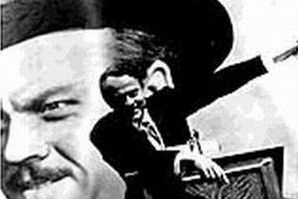
Motion Pictures and the Six Perspectives
Personal Perspective
- Movies began as scenes of everyday life. In the very beginning, seeing a scene of a moment in time was new and exciting. As time went on people demand more. Later moviemakers focussed on political, and aesthetic options.
- Movie theatres can be seen as magical places that transport the audience to different places and points of view; however, today more and more of our viewing is taking place outside of movie theatres
Historical Perspective
- Movies had to adapt throughout history. Studio executives, directors and inventors have had to keep the medium relevant
- Richard Maddox in 1871 created the gelatin-bromide dry plate process laying the ground for the creation of film
Eadweard Muybridge
- Eadweard Muybridge (1830-1904) was a British-born photographer, known primarily for his early use of multiple cameras to capture motion, and his creation the zoopraxiscope, a device for projecting motion pictures (pre-dating celluloid film.
- Muybridge was hired by Leland Stanford to scientifically prove the question of whether during a horse's gallop, all four hooves were ever off the ground at the same time.
The series of photos, taken Stanford University, called The Horse in Motion, shows that the hooves all leave the ground — although not at the point of full extension forward and back, as contemporary illustrators tended to imagine, but rather at the moment when all the hooves are tucked under the horse, as it switches from "pulling" from the front legs to "pushing" from the back legs. The photographs also show that each hoof hits the ground just as another is leaving it, so a horse at full gallop is indeed deriving traction from only one hoof at a time.
- He conducted research to improve the chemistry of his development methods to better capture motion in his photography.
Muybridge invented the Zoopraxiscope, a machine similar to the Zoetrope, but that projected the images so the public could see realistic motion.
The system was, in many ways, a precursor to the development of the motion picture
George Eastman
- George Eastman's Roll Film, 1888
George Eastman (1854-1932) contributed greatly to the field of photography.
He developed dry plates, film with flexible backing, roll holders for the flexible film, a Kodak camera (a convenient form of the camera for novices), and an amateur motion-picture camera.
Thomas Edison and William Dickson
- Edison bought a number of Muybridge's motion studies. Thomas Edison in 1880s had the idea of etching pictures on his phonograph cylinders- one of his assistants Dickson switched to celluloid film to demonstrate synchronized motion with sound - together they produced the first preserved motion picture Ott's Sneeze -see it here
- Thomas Edison Patented the Kinetoscope in 1887 -Kinetoscope, a single-viewer peep-show device in which film was moved past a light.
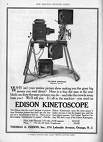
- Early movies showed dancers, clowns or other entertainers- Edison's patent did not cover Europe and Robert Paul fitted the camera with a hand crank that allowed portable set-ups so that filming did not have to only take place in the studio
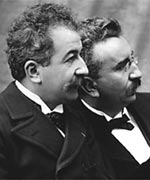 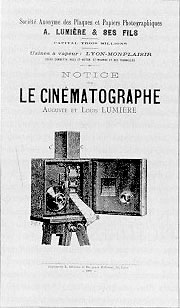 |
Their catalogues grew from 358 titles in 1897 to 1000 in 1898 to 2113 in 1903; although out of the 2113 titles in the 1903 catalogue, less than 50 were the brothers. The rest were taken by other operators
|
|
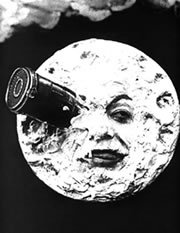 |
Action Adventure Film
- Edwin S Porter worked for Edison and showed his films under name Thomas Edison Jr. His films The Life of an American fireman and The Great Train Robbery in 1903 show action and drama -see the Great train Robbery at https://www.youtube.com/watch?v=Bc7wWOmEGGY
Blockbusters
- The First Blockbuster-D.W Griffith created The Birth of a Nation- it shows his film techniques but unfortunately is a racist story of how a struggling US is attacked by African Americans (Played by whites in blackface) and is saved by the Klu Klux Klan
- Birth of a Nation cost $83,000, they increased ticket price; many leading politicians condemned the movie; in Boston a race riot followed, but the film made $20 million; it was the first film shown in the White House ( the 3/1/2 hour film can be seen at https://www.youtube.com/watch?v=iEznh2JZvrI **Caution racist content**)
- Griffith with others went on to found United Artists. For the last years of his life he lived as a hermit
- Silent films established movies, directors, "stars"
- Adolph Zukor a Hungarian immigrant started with a movie theatre and later started Paramount Pictures; Metro-Goldwyn- Mayer MGM was created by Marcus Loew, Sam Goldwyn and Louis B Mayer- most production was in Hollywood- in 1912 Warner brothers was formed
- Directors became famous like Mack Sennett, Frank Capra, Hal Roach- the most famous silent director was Cecil B DeMille (1923 Ten Commandments)
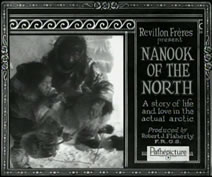
Robert Flaherty shot a Canadian Eskimo's struggle in 1913 Nanook of The North- an example of early documentary work . It can be seen at
clip http://www.youtube.com/watch?v=cLERFRQl5EY
Nanook remains the first great nonfiction film. With the help of Nanook and his friends and family, Flaherty undertook the mission of re-creating an Eskimo culture that no longer existed in a series of staged scenes. Thus as the first documentary there is controversy
There is a conflict between the explorer-scientist who had been disciplined into giving facts and figures and the story-teller-turned-film-director who left out certain facts and emphasized others. Flaherty began a tradition of participatory filmmaking which continues today.
- Fritz Lang's futuristic Metropolis in 1926 was noted for its visual effects. Lang was invited by Hitler to make propaganda films, but he fled Germany to Hollywood (see Metropolis here http://www.youtube.com/watch?v=j92E9J8uafc
- Leni Riefenstahl influenced by Lang created Triumph of Will and many propaganda films for Hitler (see it at https://www.youtube.com/watch?v=GHs2coAzLJ8
- Russian Sergei Eisenstein produced Battleship Potemkin notable for famous "steps" scene with quick editing to produce tension(https://youtu.be/DLEE2UL_N7Q



 actors became stars like Canadian Mary Pickford, Charles Chaplin, Douglas Fairbanks , Rudolph Valentino
actors became stars like Canadian Mary Pickford, Charles Chaplin, Douglas Fairbanks , Rudolph Valentino
Scandals
- Sensuality on screen and off caused concern that movies could corrupt the people- a censorship board was created- Fatty Arbuckle was involved in a 1921 scandal where a young actress died in his hotel- even though found not guilty he was ruined by attacks in Hearst newspapers- this led to formation of Motion Picture s and Produces and Distributors of America who offered advice on movie content; without approval a film was doomed to low budget status- this led to sanitized work of 30s and 40s
Oscars/Hollywood innovations
- First Academy Awards were on May 16, 1929 as public relations ploy to dignify the industry
- technical innovations of 30s and 40s made people flock to films
- Lee De Forest's invention of audio tube led to public address systems, radio and TV. AT&T bought the technology
- Two sound systems were available- Vitaphone (sound on disk) and Phonofilm (sound on film)
- Vitaphone required film and sound to run on separate devices
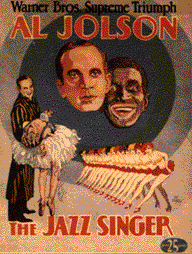 |
The Jazz Singer with Al Jolson used Vitaphone ( only 4 sequences have sound and only a few moments of dialogue) The songs and dialogue sequences created a sensation among movie going audiences of the day. The film that ushered in the talkies was The Jazz Singer, one of the very few films to deal with the Jewish experience-the story of the conflict between an aged cantor and his young, assimilated son who wanted to enter show business. It starred an actor who plays his role in blackface. It is a story of assimilation and Americanization, but it contains a highly offensive racial image. Racism combined with the expropriation of African American identity was part of the way that immigrants became Americans. Hollywood films like Birth of a Nation, The Jazz Singer, and Gone With the Wind romanticized the Old South, reinforced racial stereotypes, and intensified racial divisions. (source: http://www.class.uh.edu/mintz/places/film-3d-early_holly_race.html by Steven Mintz - link no longer active) see a clip of Jolson in Blackface singing Mammy https://www.youtube.com/watch?v=PIaj7FNHnjQ |
- Critics and studios were not that keen on talking film- the added cost and the difficulty of production
- Because of two competing techniques studios met and decided to hold off until there was a clear winner
- A later version of Phonofilm ( sound on film) was eventually adopted-synchronization revived the slumping industry
- First full length colour film was in 1914- first three colour process was 1926- Disney used it early- technicolour in 1937 with A Star is Born and in 1939 Gone with the Wind
Citizen Kane- Orson Welles
|
Adapting a 40-year-old sci-fi novel, Orson Welles's 1938 radio broadcast of War of the Worlds convinced Americans that New York was under attack by Martians.
|
- Wide screen became standard- 1952 Cinerama commercial wide screen- then CinemaScope (Panavision)
- Early directors made dozens of movies per year
- WWII delayed the real introduction of TV allowing movies to remain popular; after the war movie attendance soared
- at the beginning of Cold War with Soviet Union 1947 US house of Representatives formed the House Un-American Activities Committee (HUAC) to weed out communists and sympathizers- the committee ruined numerous careers many were blacklisted- "The Hollywood Ten" reformed in 1951 with help of Joseph McCarthy Ronald Reagan, Richard Nixon 300 people were blacklisted
- One dissenter was television reporter Edward R Murrow who exposed McCarthy's tactics; in 1954 McCarthy was censured by the senate
- Eager to please studios produced movies like I married a Communist, sci-fi movies with subtle political links, atom bomb mutants. Invasion of the Body Snatchers (1956) and alienated teen movies like Rebel without a Cause (1955) and The Wild One (1954)
Technical Perspective
Take a few minutes to watch this short video of the evolution of special effects. Which of the examples in the video do you recognize?
Visual
- The shot: Basic unit of movie is the shot ( a continuous picture without cuts)- in 2002 Russian Ark by Alexandr Sokurov used one continuous shot for the 200 year history played out in the Hermitage Museum
- Shots can be static-camera lens doesn't move where focus is on actors
- Dynamic shot- camera and lens manipulated to direct attention to different areas
- Tension can be emphasized with a slow zoom=zoom out distances viewer and is often a last scene
- Camera movements can show different movie types- minimal camera movements identify objective direct cinema approach; handheld is cinema verite- making viewer feel part of scene
- Documentary approach acknowledges that camera influences and the viewer is aware of the filmmaker and camera
- Lots of quick cuts can create a frenetic effect- example Hitchcock's Psycho showers scene- see the series of shots at http://faculty.cua.edu/johnsong/hitchcock/pages/stills/shower-1.html
- Film choices- B&W, colour or combo- B&W is associated with serious documentary subjects- Wizard of OZ uses both- Kansas is B&W Oz is colour
- Some B&W films can be haunting such as In Cold Blood and Raging Bull- purists dislike when B&W is colourized
- Text must be designed for screen
- Today, special effects are an important component
Audio
- Sound effects heighten sense of realism- three parts-speech, music and noise
- Automatic Dialogue Replacement (ADR) is often necessary especially if there is on location noise
Ethical Perspective
- Main ethical concerns: stereotypes, violence, sexual content, promotion of smoking, copyright infringement
Stereotype
- As mentioned above Birth of a Nation was clearly racist with the characterization of blacks as sexualized beasts
- Attempts to ban the film were not successful- the blacks were played by whites in blackface which was common on stage and screen; when blacks were hired they played stereotyped maids, butler, or buffoon, later directors used blacks motivated with good intentions but subtle condescension
- When Hattie McDaniel won the first supporting Academy Award for a black for Gone with the Wind- the role was that of a mindless maid- a stereotype
- In the 60s Black Power movement criticized the industry and lobbying improved things somewhat- Sidney Poitier became first black movie star
- 1970s blackploitation movies produced like Shaft with all black casts for a black audience; the films were attacked from many angles as showing negative stereotypes of blacks as well as other groups
- Later movies such as Austin Powers in Goldmember (2002) and Undercover Brother (2002) , as well as Quentin Tarantino’s Jackie Brown (1997) and Kill Bill, Vol. 1 (2003), feature pop culture nods to the blaxploitation genre.
- Directors like Spike Lee and John Singleton have produced movies that go beyond stereotype, yet most films about blacks still focus on crime and sex and continue the stereotypes
- A step forward was in 2001 when best actor and actress awards went to Denzel Washington and Halle Berry
- Natives in early films were always shown as murderous savages; Arabs are stereotyped, Asians are stereotyped as dragon lady and kung-fu master
- Women have been and continue to be stereotyped-after WWII the dumb blonde was a fixture- 70s showed more realistic portrayals
- Still only a very small percentage of directors are women. Only 4 women directors have been nominated for Oscar: Lina Wertmüller for Seven Beauties (1976), Jane Campion for The Piano (1993), Sofia Coppola for Lost in Translation (2003), and Kathryn Bigelow for The Hurt Locker (2009). Bigelow is the only one to win the Academy Award for Best Director.
Diversity
Oscars So White.
- As soon as the oscar nominations were announced in 2016, a backlash began because of the lack of nominations for Black artists. Some boycotted the Oscars and others used the hashtag #OscarsSoWhite. We can hope that this movement makes a difference, but the problem is deeper than just the nominations. It's about what movies are made, how they are funded, decision makers, casting and so much more.
- See these articles to learn more http://www.latimes.com/entertainment/la-et-oscars-so-white-reaction-htmlstory.html. and http://www.huffingtonpost.com/news/oscars-so-white/
Violence
- Action-adventure with violence has long been popular and has been blamed for problems in society- but it will remain popular and increases as studios seek the blockbuster to fill seats and keep the medium viable- also a large overseas market
- Violence in movies has changed. Early directors like Hitchcock had violent themes but rarely showed actual violence. In Psycho the actual stabbing is not shown. Dramatic effect leads us to the action in many of Hitchcock's films; we know what happened but we don't need to see it
Sex
- Since 1990 Motion Picture Association changed it's rating system from X to NC-17-one step past R restricted rating- NC-17 is thought of a box office killer- several films since have received the rating but not for violence but sex
Smoking in Movies
- A 5 year study found that 80% of 776 Hollywood and independent movies included smoking- 90% of R rated and 89% of PG-13 and 50% of G and PG
- Smoking in movies today is higher than in the 50s
- Children are highly influenced and advocacy groups are demanding changes see http://www.scenesmoking.org/ and http://smokefreemovies.ucsf.edu/problem/moviessell.html
Copyright Infringement
- Piracy of movies by downloading is an issue, as well as filming in theatres
- Eight people were charged with Copyright Infringement for Distributing the Star Wars Movie that was Stolen from Post-Production Firm Prior to Release (September 27, 2005)
- Sites like YouTube and Google video allow users to upload content from clips to movies-this increases the possibility of copyright infringement. So is it OK to watch movies on these sites.?..
Cultural Perspective
- Movies like other visual media reflect the archetypes of a culture and shape our view of society and ourselves- a star is an ideal, we see good v evil, etc.
Genres: Comedy, Crime, Documentary, Epic, Horror, Musical, Romance, Science Fiction, Social Impact, Thriller, War, Western
- Mythic stories are told with symbolism; movies are cultural artifacts; they affect us emotionally because of powerful visual messages.
- Because our society is diverse, we need to try to ensure that every group is represented, but also represented in a respectful way.
Critical Perspective
- Movie attendance has been declining since WWII because of TV, computer and internet
- Today DVDs video games, streaming media sites like Netflix and other multimedia are threats, but the DVD is dying, movie going is stalled as a technological shift to digital is happening
- More and more movies are being released online; “Average time spent with digital media per day will surpass TV viewing time for the first time this year,” announced a recent report from eMarketer.
- Studios go for summer blockbuster with proven formula with mass appeal-remakes, sequels, sex, violence
- For films to have lasting cultural influence directors need the freedom to make them- money trumps independence, but much of money comes from advertisers who have product placement and product tie-ins.
_______________________________________________________________________________________________________________
Sources/ Resources
Academy Award History http://www.oscars.org/aboutacademyawards/history01.html
A re-examination of Robert Flaherty http://astro.temple.edu/~ruby/ruby/flaherty.html
Adventures in CyberSound: Light, Smoke and Mirrors http://www.acmi.net.au/AIC/LIGHT_SMOKE_L.html
Citizen Kane Anatomy of a Classic ( May 4, 2013) http://youtu.be/gCez9Pgqb5s
Decker, Kerry. Kerry Decker TV Show on early sound process http://www.youtube.com/watch?v=frPcFnVnXa0
Duck and Cover (1951) Propaganda https://www.youtube.com/watch?v=IKqXu-5jw60
Ebert, Roger. ( May 24, 1998) Citizen Kane http://rogerebert.suntimes.com/apps/pbcs.dll/article?AID=/19980524/REVIEWS08/401010334/1023
Eisenstein, Sergj. (1925) Battleship Potemkin https://www.youtube.com/watch?v=7TgWoSHUn8c
Film: How it all started http://www.cybercollege.com/frtv/frtv001.htm
Film as history http://www.digitalhistory.uh.edu/historyonline/hollywood.cfm
First Academy Awards http://www.themediadrome.com/content/articles/film_articles/first_academy_awards.shtml
Flahrety, Robert. (1921) Nanook of the North https://www.youtube.com/watch?v=cLERFRQl5EY
Grant, Barry Keith. (April 20, 2011) Genre films and cultural myth. Film International http://filmint.nu/?p=1689
Griffith. D.W. Birth of a Nation http://www.youtube.com/watch?v=iEznh2JZvrI
Hitchcock's Psycho Shower Scene http://faculty.cua.edu/johnsong/hitchcock/pages/stills/shower-1.html
Hollywood and Race http://www.class.uh.edu/mintz/places/film-3d-early_holly_race.html
Kinetophones http://inventors.about.com/library/inventors/bledison_kinetoscope.htm
Lang. Fritz. ( 1927) Metropolis http://www.youtube.com/watch?v=B8sraSoClbI
Lee De Forest http://www.leedeforest.org/
Lee De Forest - PBS https://www.pbs.org/transistor/album1/addlbios/deforest.html
Lester, Paul Martin. ( 2014) Visual Communication: Images with Messages, Pearson Education.
McCay, Winsor. (1918) The Sinking of the Lusitania https://archive.org/details/Sinking_of_the_Lusitania
Méliès, Georges. (1902) Voyage dans la Lune Georges Le/A Trip to the Moon (France, ) https://www.youtube.com/watch?v=7JDaOOw0MEE first science fiction
Oldest Movies http://www.cinescene.com/dash/lumiere.html
Porter, Edwin. (1903) The Great Train Robbery http://www.youtube.com/watch?v=BINBZE5XFR4
Rosen, David. (Aug, 9, 2013) In the Age of Digital Disruption, What is a Movie., Filmmaker Magazine. http://filmmakermagazine.com/75457-in-the-age-of-digital-disruption-what-is-a-movie/
Smoking in Movies http://www.scenesmoking.org/ and http://smokefreemovies.ucsf.edu/problem/moviessell.html and http://www.tobaccofree.org/films.htm
Stars and movie culture in the 1920s, film reference.com http://www.filmreference.com/encyclopedia/Romantic-Comedy-Yugoslavia/Silent-Cinema-STARS-AND-MOVIE-CULTURE-IN-THE-1920s.html
Thomas Edison Kinetoscope http://www.americaslibrary.com/cgi-bin/page.cgi/jb/gilded/kinetscp_1
The Trial of Fatty Arbuckle http://www.ralphmag.org/fatty.html or http://history1900s.about.com/od/famouscrimesscandals/a/fattyarbuckle.htm
This week in copyright infringement http://news.com.com/This+week+in+copyright+infringement/2100-1026_3-5722887.html
You tube infingement http://arstechnica.com/news.ars/post/20060329-6481.html
Violence in movies prevalent whether its PG-13, R film: Study ( Dec 9, 2013), CBS News http://www.cbsnews.com/news/violence-in-movies-a-concern-whether-its-pg-13-r-film-study/
War of the Worlds http://news.nationalgeographic.com/news/2005/06/0617_050617_warworlds.html and http://xroads.virginia.edu/~1930s/RADIO/WOTW/frames.html

